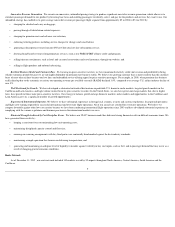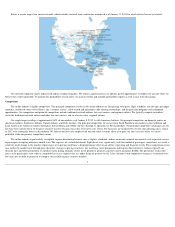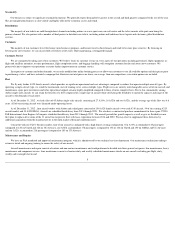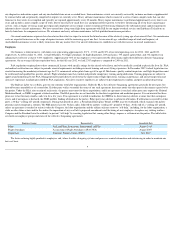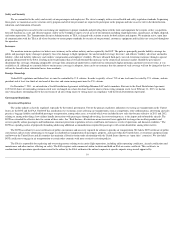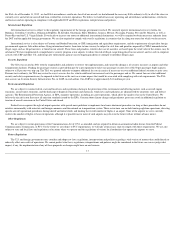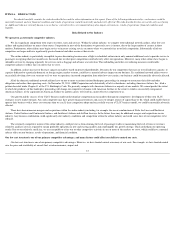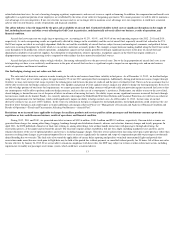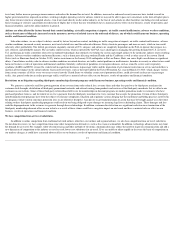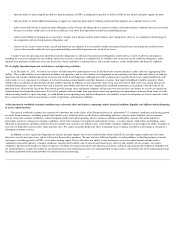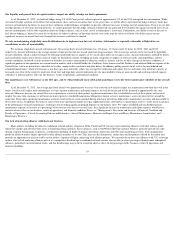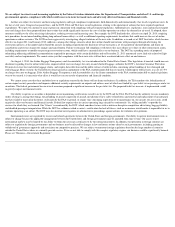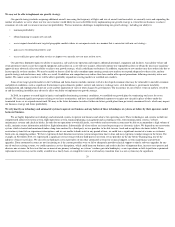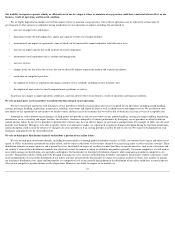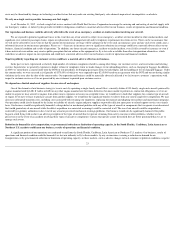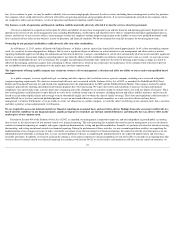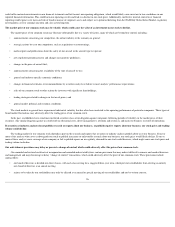Spirit Airlines 2012 Annual Report Download - page 17
Download and view the complete annual report
Please find page 17 of the 2012 Spirit Airlines annual report below. You can navigate through the pages in the report by either clicking on the pages listed below, or by using the keyword search tool below to find specific information within the annual report.
Risks Related to Our Business
Increased labor costs, union disputes, employee strikes and other labor-related disruption may adversely affect our business, results of operations and financial
conditions.
Our business is labor intensive, with labor costs representing approximately 19.1% , 19.6% and 22.0% of our total operating costs for 2012 , 2011 and 2010 ,
respectively. As of December 31, 2012 , approximately 54%
of our workforce was represented by labor unions and thereby covered by collective bargaining agreements. We
cannot assure you that our labor costs going forward will remain competitive because in the future our labor agreements may be amended or become amendable and new
agreements could have terms with higher labor costs; one or more of our competitors may significantly reduce their labor costs, thereby reducing or eliminating our
comparative advantages as to one or more of such competitors; or our labor costs may increase in connection with our growth. We may also become subject to additional
collective bargaining agreements in the future as non-unionized workers may unionize.
Relations between air carriers and labor unions in the United States are governed by the Railway Labor Act, or the RLA. Under the RLA, collective bargaining
agreements generally contain “amendable dates” rather than expiration dates, and the RLA requires that a carrier maintain the existing terms and conditions of employment
following the amendable date through a multi-stage and usually lengthy series of bargaining processes overseen by the National Mediation Board, or the NMB. This process
continues until either the parties have reached agreement on a new collective bargaining agreement, or the parties have been released to “self-help” by the NMB. In most
circumstances, the RLA prohibits strikes; however, after release by the NMB, carriers and unions are free to engage in self-help measures such as lockouts and strikes.
Our flight operations were shut down due to a strike by our pilots beginning on June 12, 2010 and lasting until we and the union representing our pilots reached a
tentative agreement for a new contract. Under a Return to Work Agreement, we began to resume flights on June 17, 2010 and resumed our full flight schedule on June 18,
2010. On August 1, 2010, we and the pilots’ union executed a five-year collective bargaining agreement. This shutdown had a material adverse effect on our results of
operations for 2010. Please see “Management’s Discussion and Analysis of Financial Condition and Results of Operations—June 2010 Pilot Strike.”
Our collective bargaining agreement with our flight attendants became amendable in August 2007, and we are currently engaged in negotiations with the union
representing our flight attendants. Our collective bargaining agreement with our dispatchers became amendable in July 2012. The outcome of our pending collective
bargaining negotiations cannot presently be determined and the terms and conditions of our future collective bargaining agreements may be affected by the results of
collective bargaining negotiations at other airlines that may have a greater ability, due to larger scale, greater efficiency or other factors, to bear higher costs than we can. In
addition, if we are unable to reach agreement with any of our unionized work groups in current or future negotiations regarding the terms of their collective bargaining
agreements, we may be subject to work interruptions or stoppages. Any such action or other labor dispute with unionized employees could disrupt our operations, reduce our
profitability, or interfere with the ability of our management to focus on executing our business strategies. Our business, results of operations and financial condition may be
materially adversely affected based on the outcome of our negotiations with the union representing our flight attendants.
We have a significant amount of aircraft-related fixed obligations that could impair our liquidity and thereby harm our business, results of operations and
financial condition.
The airline business is capital intensive and, as a result, many airline companies are highly leveraged. All of our aircraft are leased, and in 2012 and 2011 we paid the
lessors rent of $140.8 million and $116.6 million , respectively, and maintenance deposits net of reimbursements of $31.6 million and $36.8 million , respectively. As of
December 31, 2012 , we had future operating lease obligations of approximately $1.2 billion . In addition, we have significant obligations for aircraft and spare engines that
that we have ordered from Airbus and International Aero Engines AG, or IAE, (or any other engine manufacturer for future deliveries) for delivery over the next nine years.
Our ability to pay the fixed costs associated with our contractual obligations will depend on our operating performance, cash flow, and our ability to secure adequate
financing, which will in turn depend on, among other things, the success of our current business strategy, whether fuel prices continue at current price levels and/or further
increase or decrease, further weakening or improving in the U.S. economy, as well as general economic and political conditions and other factors that are, to some extent,
beyond our control. The amount of our aircraft related fixed obligations could have a material adverse effect on our business, results of operations and financial condition
and could:
16
• require a substantial portion of cash flow from operations for operating lease and maintenance deposit payments, thereby reducing the availability of our cash flow
to fund working capital, capital expenditures and other general corporate purposes;


